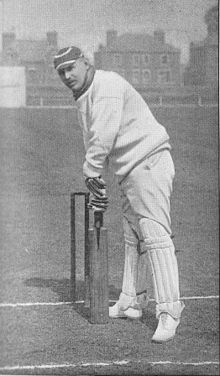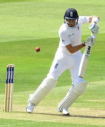Give me Arthur
Gareth Bland |
The great Nottinghamshire stalwart Arthur Shrewsbury was so commanding a batsman during the late 1880s that he was acknowledged among his contemporaries as almost peerless. In fact, so consummate a technician was Shrewsbury that he was first choice of that eminent Victorian, WG Grace. The invocation “Give me Arthur” attributed to Grace, became synonymous with Shrewsbury, the quiet taciturn Nottinghamshire lad.
Cricket, sadly, is not a game which is a stranger to personal tragedy among its initiates and Arthur Shrewsbury was one of the game’s most notable casualties; his death coming by his own hand in 1903, barely a month after his 47th birthday. Following a bout of depression, Shrewsbury shot himself in May of that year just as the English season was in its stride. Arguably his greatest innings, however, and a knock which was a testament to his strokeplay, pacing, temperament and technique came at the home of cricket in 1886 against the touring Australians in the second Test at Lord’s. At the age of 30, and with his peak years stretching out in front of him, Shrewsbury took on an Australian bowling attack of Garrett, Evans, Palmer, Trumble and last, but by no means least, Fred “The Demon” Spofforth, Australia’s first truly penetrative pace bowler. Then 33, Spofforth had the appearance of a Victorian pantomime villain, with luxuriant moustache, slicked down, centre-parted hair and high leap into the delivery stride to boot. With his indefatigability, he was the Lillee of his day, and just as inspirational to his team-mates and the Australian public alike.
Although popularly acknowledged as the superior team in that 1886 series, England had only narrowly beaten the tourists in the opening encounter in Manchester by four wickets. Chasing 106 for victory, Spofforth and Giffen had exploited conditions to bowl with nagging accuracy, leaving England precariously poised on 24-3 in the early stages of the chase, with Grace, Shrewsbury and Read all back in the pavillion. Eventually the captain, Steel, with an unbeaten 19, led the home side to the win on what was George Lohman’s Test debut.
Arriving at Lord’s for the second Test, England chose to bat first where Shrewsbury soon found himself navigating his way through the Long Room as Grace was dismissed with the score on 27. Thereafter Shrewsbury dominated the innings completely. His 164 was far and away the highest score of the Test, with William Barnes’ 58 being next best. Barnes, Shrewsbury’s Nottinghamshire team-mate, accompanied Arthur while 161 runs were scored and while also acting as very much the junior lieutenant in the partnership.
Having each surmounted the variable conditions, both atmospheric and on the playing surface, the pair established an impregnable position from which England then ran out easy winners by an innings. The innings was heralded as an instant classic and Wisden was unstinting in its eulogy in the following year’s Almanack:
“Shrewsbury and Barnes continued batting, and the latter was not dismissed until the score had reached 280, the famous Nottingham pair having added during their partnership no fewer than 161 runs. Later on Ulyett hit freely for 19, and ultimately the innings closed for 353. Shrewsbury, who had gone in first wicket down with the score at 27, was the last man out, and too much praise cannot be afforded him for his most extraordinary performance. He was at the wickets for six hours and fifty minutes, and though he gave a couple of difficult chances, there was scarcely any fault to be found with his batting. It should be stated that the wicket on this morning was rapidly improving, but Shrewsbury had thoroughly mastered all the varying conditions of the ground. His figures were sixteen 4’s, eight 3’s, sixteen 2’s, and 44 singles, and up to this time his 164 was the largest score, ever made against Australian bowling in England”
In his authoritative mastery of the bowlers and the conditions, and in his disproportionate scoring of so many of his team’s runs, Shrewsbury’s magnum opus at Lord’s in 1886 has more than a ring of the Graham Gooch effort at Headingley some 105 years later. Whereas Gooch scored an unbeaten 154 out of 252 against Marshall, Patterson, Walsh and Ambrose in murky light and on an indifferent pitch, Shrewsbury had been equally dominant here. His 164 simply dwarfs any other contribution with the bat. Following England’s 353, Australia were shot out twice for 121 and 126 to grant England a victory by an innings and 106 runs.
In 1893 Shrewsbury returned to Lord’s to stymie the Australian advance once more, with a sublime, matchless 106 in similarly testing conditions. Shrewsbury’s great skill was in being able to combat surfaces even his most esteemed of colleagues found unplayable. After 11 years as a Test player and with 27 years service with his native Nottinghamshire, Arthur Shrewsbury was gone too soon at the age of 47. The impact he made as a batsman and his innate modesty, though, ensured that this titan of a batsman, a beloved son of New Lenton in the Robin Hood county, had a reputation which made him universal





Nice read. Poor soul lost so early.
Comment by Maja | 12:00am BST 7 August 2013